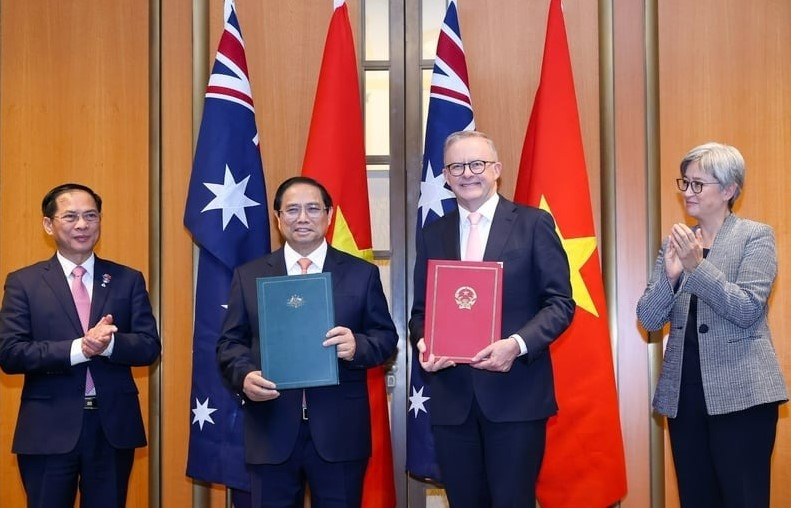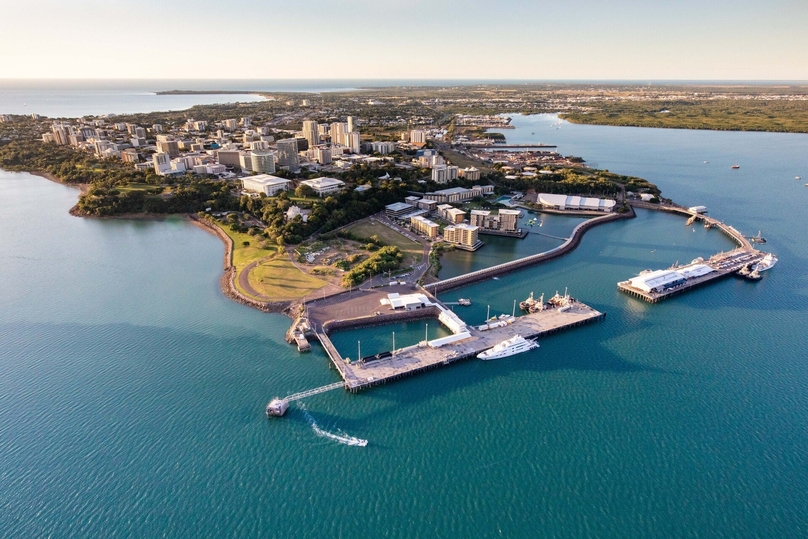'Good time' for Vietnam firms to increase presence in Australia’s Northern Territory
Australia’s Northern Territory has great potential for development, and Vietnamese businesses should stand ready to increase their presence in the territory, said Nguyen Ngoc My, vice chairman of the Vietnam's Association of Foreign Invested Enterprises (VAFIE) and chairman of the Northern Territory-Vietnam Business Council (NTVBC).
Australia’s Northern Territory has great potential for development, and Vietnamese businesses should stand ready to increase their presence in the territory, said Nguyen Ngoc My, vice chairman of the Vietnam's Association of Foreign Invested Enterprises (VAFIE) and chairman of the Northern Territory-Vietnam Business Council (NTVBC).
On March 7, 2024, Prime Minister Pham Minh Chinh and his Australian counterpart Anthony Albanese announced the upgrading of Vietnam-Australia ties to a Comprehensive Strategic Partnership. Notably, the two sides agreed on six major orientations. Is this an opportunity for Vietnamese businesses to expand investment in Australia and the Northern Territory?
Vietnamese PM Pham Minh Chinh paid an official visit to Australia from March 5-9, 2024 at the invitation of his Australian counterpart Anthony Albanese. A highlight of the visit, the two PMs announced the upgrading of Vietnam-Australia relations to a Comprehensive Strategic Partnership.
During the visit, made at the invitation of Australian PM Anthony Albanese, the two leaders agreed to coordinate closely on six major orientations: building strategic diplomatic-political trust; achieving more inclusive, substantive, and effective economic, trade, and investment cooperation, tapping the potential of the two highly complementary economies; promoting stronger cooperation in science-technology, innovation, digital transformation, and green transition; stepping up cooperation in culture, education-training, environment and climate change response; enabling more open and sincere people-to-people exchanges and connections; and achieving better understanding on security-defense cooperation.

Vietnamese Prime Minister Pham Minh Chinh and his Australian counterpart Anthony Albanese exchanged statements on upgrading the two countries' relationship to a Comprehensive Strategic Partnership on March 7, 2024. Photo courtesy of the Vietnamese government's news portal.
Is this an important time for Vietnamese businesses to increase their presence in Australia in general and the Northern Territory?
The bilateral relationship between Vietnam and Australia has seen remarkable developments since the two countries established official diplomatic relations in 1973. On March 15, 2018, the two governments signed a joint statement on establishing the Vietnam-Australia Strategic Partnership, which has been upgraded under the Comprehensive Strategic Partnership.
Although Vietnam and Australia have a close diplomatic relationship and their economies have many different and complementary factors, the two-way trade turnover is not commensurate with their potential. Australian businesses now see Vietnam as an alternative market for diversification. However, I still want to affirm that Vietnam and Australia share the same aspirations in promoting bilateral trade and investment to support sustainable economic growth.
In fact, there is very little direct competition in the trade structure between Australia and Vietnam, providing opportunities for deeper trade cooperation. Vietnam has diversified its products in greater and greater quantities, making it more competitive and attractive to Australian customers.
As Vietnam's economy continues to grow and people's living standards further improve, the demand for energy, raw materials, food, and education is also increasing. Both countries benefit from economic growth, each country's strengths help meet the other's needs. In the long term, I appreciate the sustainable development between Vietnam and Australia.
The Vietnam-Northern Territory Business and Investment Cooperation Strategy is underway now. What issues does this strategy target?
When mentioning Australia, we often think of famous cities like Canberra, Sydney, and Melbourne. But in fact, in terms of strategic geographical location, the Northern Territory's capital Darwin plays a unique role as the closest gateway connecting Asia with the rest of Oceania. In addition, the Northern Territory is rich in natural resources such as oil-gas and minerals, and boasts Aboriginal cultural heritage and many majestic nature reserves. It has the highest GDP per capita in Australia, with an area four times larger than Vietnam’s but a much smaller population.
Trade cooperation between Vietnam and Australia mainly focuses on Sydney and Melbourne, while the Northern Territory is rarely mentioned. The Australian economy in general and the Northern Territory in recent years have been struggling to gradually escape from China's influence. This is an opportunity for Vietnam to increase its presence in the territory and Australia as a whole.
To avoid too much competitive pressure in Sydney and Melbourne, some overseas Vietnamese businesses have shifted to investing in the Northern Territory to benefit from its preferential policies.
With 50 years of experience as a project developer, including 20 years in Australia, I realize that the Northern Territory has great potential and ample room for development. With what the two countries are doing, as well as the orientations of both governments, I am confident that the Vietnam-Northern Territory Business and Investment Cooperation Strategy will be highly feasible and soon be realized.
The strategy to promote business and investment cooperation in the Northern Territory will be a balance of benefits between the two sides, based on their competitive advantages to boost win-win cooperation. However, to make the strategy successful, it requires consensus of relevant parties, contribution of socio-economic experts and scientists, and especially the dynamism and daring to think big among Vietnamese businesses.

Darwin, capital of the Northern Territory. Photo courtesy of Nearfarproductions.com.
Could you tell us about the opportunities for Vietnamese businesses that want to invest in the Northern Territory?
Currently, there are many Vietnamese businesses investing in foreign countries, including Australia, so the Northern Territory will be a land with great potential and advantages for them.
The Northern Territory is very short of human resources and has a mammoth demand for supplies and construction materials to develop economic infrastructure. This is a huge competitive advantage for Vietnam at present and in the future. We can take advantage of the relatively low cost of unskilled labor to produce construction materials that are in high demand in the Northern Territory.
In addition, we can also make use of the abundant raw materials of naturally raised buffaloes and cows in the Northern Territory to invest in slaughterhouses and freezing facilities for imports to Vietnam.
Vietnamese businesses can exchange tours combined with market surveys and promote cooperation in business and vocational training in the Northern Territory, as well as export highly skilled labor to the region.
To promote the Vietnam-Northern Territory Business and Investment Cooperation Strategy, what do you think needs to be done?
The two governments are increasingly promoting bilateral cooperation. In 2021, Vietnam and Australia announced a strategy to enhance economic cooperation to open up new opportunities for their businesses. This is an important premise, especially when the Vietnam-Northern Territory Business and Investment Cooperation Strategy is realized.
Therefore, I hope that this strategy will receive proper attention from the Party and Government so that it can be included in the high-level diplomatic agenda between Vietnam and Australia.
I also call on business associations to disseminate this strategy to each of their members in order to take advantage of the opportunity to access a business and investment environment with great potential like the Northern Territory, considering it a stepping stone to realize Vietnamese enterprises’ dream of “going to the big sea”.
With your role and positions, what will you do to promote business and investment cooperation with Australia and the Northern Territory?
As chairman of the Vietnam-Northern Territory Business Council, I will have the opportunity to connect not only overseas Vietnamese businesses but also foreign businesses from the Northern Territory in particular and Australia in general with Vietnam.
At the same time, I will bring Vietnamese businesses to Australia and the Northern Territory. I will act as a bridge for them, set up warehouses, distribution and business facilities, and create partnerships at a ratio of 7-3, 4-6 or 6-4, depending on the investment capital and aspirations of each party.
I am investing in developing a cattle farm, slaughterhouse, factory, logistics service center, construction material warehouse, tourism infrastructure, and product display center on more than 1,000 hectares in the outskirts of Darwin.
The purpose is to build a foundation to support investment cooperation between Vietnamese and Australian businesses. This is a pilot model that will help domestic businesses cooperate with overseas Vietnamese peers in the host country to create distribution systems and penetrate the market.
This model, if successful, needs to be supported, promoted, and replicated by Vietnamese diplomatic representative agencies and trade offices in foreign countries.
In addition, in my role as vice chairman of VAFIE, I want to help domestic businesses promote trade and investment abroad through the overseas Vietnamese business network system, starting with the pilot model in Darwin.




